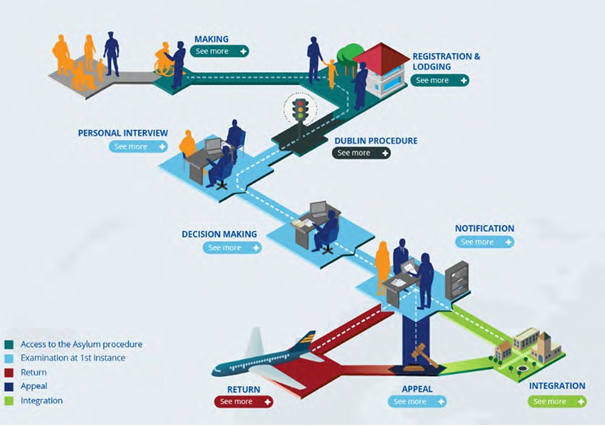Background information
The asylum procedure is the administrative procedure through which a Member State determines whether an applicant for international protection qualifies for refugee status or subsidiary protection. The determining authority may also decide on the admissibility of the application. For further information on admissibility, see topic 'Next steps if the application is channelled through a special examination procedure'.
To ensure respect for the principle of non-refoulement (37) and for the right to asylum to be effective, every person who may be in need of international protection must be ensured access to the asylum procedure (38).
The access to asylum procedures comprises three different phases: making an application, registering and the lodging. Making an application is the act of expressing, in any way and to any authority, one’s wish to apply for international protection. Then, the application is registered. Finally, lodging an application means for the applicant to provide information/documents to complete the file created at the time of registering the application (39). Lodging of the application triggers the start of the first-instance examination. These three procedural steps can be conducted concurrently or separately, depending on the national set-up or the location where the application is made. Even in these cases and even if the 3 steps are done at the same time, all procedural guarantees should be ensured.
The asylum procedure then continues with the examination phase, where the personal interview is the core. The personal interview provides an opportunity to, the applicant to explain why they cannot return to their home country, even when they cannot provide documentary evidence of the feared persecution or serious harm (40). The applicant can submit additional elements, provided a decision has not yet been taken and notified to the applicant.
After the personal interview, the application is assessed and the decision on the application is made.
The decision can be:
- granting of refugee status; or
- granting of subsidiary protection; or
- the application is rejected; or (41)
- the applicant is excluded from international protection (42).
The decision on the application has to be in writing and a negative decision must state the reasons for the decision in fact and in law (43).
The applicant is notified of the decision (44), which ends the asylum procedure at first instance.
If the applicant is granted protection, the applicant will be supported in integrating into the local community/country (45).
In the event of a negative decision, the applicant has the right to an effective remedy before a court or tribunal (appeal) (46).
In case of final negative decision, the return procedure will be initiated (47).
(37) The principle of non-refoulement: the obligation of states to refrain from expelling or returning a person in any manner whatsoever to a situation where they may face persecution and/or torture, inhuman or degrading treatment or punishment.
(38) Article 6 APD (recast) ‘Access to the procedure’.
(39) Article 6 APD (recast) ‘Access to the procedure’.
(40) Article 14 APD (recast) ‘Personal interview’.
(41) Article 10 APD (recast) ‘Requirements for the examination of applications’.
(42) Article 12 and 17 QD (recast) ‘Guarantees for applicants’ and ‘Report and recording of personal interviews’.
(43) Article 11 APD (recast) ‘Requirements for a decision by the determining authority’.
(44) Article 12(1) APD (recast) ‘Guarantees for applicants’.
(45) Article 34 QD (recast) ‘Special rules on an admissibility interview’.
(46) Article 46 APD (recast) ‘The right to an effective remedy’.
(47) For more information see the Directive 2008/115/EC of the European Parliament and of the Council of 16 December 2008 on common standards and procedures in Member States for returning illegally staying third-country nationals (OJ L 348, 24.12.2008).

Explain these messages to the applicant during the first contact (making) and registration/lodging:
- The asylum procedure is a process which determines whether an applicant will be granted international protection or not.
- The asylum procedure is free of charge.
- Unless any exception apply, inform the applicant about their right to remain following making of an application for international protection.
- The application first has to be registered and lodged (for more information, see topic ‘Registration procedure’).
Explain these additional messages to the applicant during the registration/lodging:
- The authorities will assess if no other EU+ country is responsible for the examination of the application in accordance with Regulation (EU) No 604/2013 (Dublin III regulation) (for more information, see topic ‘Dublin procedure’).
- After the registration process is finalised, the applicant will be invited to a personal interview, where they can explain why they left their country (for more information, see topic 'Personal interview').
Explain these additional messages to the applicant during the registration/lodging and personal interview:
- After the personal interview, the authority will assess all available information and decide if the applicant will be granted international protection or not. The result can be granting of refugee status, subsidiary protection or the application is rejected or the applicant is excluded from international protection.
- The applicant will be notified of the decision and if they disagree, they can appeal against the decision (for more information and additional information provision messages, see topics 'Notification' and 'Appeal').

Practical tip: introducing information gradually, starting with an overview of the procedure
At the early stage of the asylum procedure, the applicant should only be provided with a basic overview of the asylum procedure in order to be aware of what steps it entails. The applicant should not be overwhelmed with detailed information during the first contact. More elaborated information will be provided at each stage of the asylum procedure. For example, you may adapt the information on the procedural steps and explain at which step the applicant currently is, which steps have been accomplished and what is next. Remember to tailor the information to the applicant’s needs.
It is advisable to support the information provision with a visual aid explaining the asylum procedure.